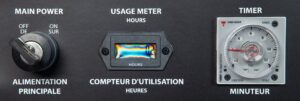Vault 160 (UV-C Disinfection Chamber)
The Aperon UV Vault 160 (275w) is a specialized chamber designed for quick object disinfection while maintaining a safe work environment. High intensity ultraviolet (UV-C) bulbs produce germicidal light (254nm wavelength) that can eliminate viruses, bacteria and other harmful microorganisms. The simple and efficient nature of the device makes it an effective disinfection tool in many commercial and industrial settings such as medical facilities, personal care homes, education institutions, retail spaces, and construction sites.



















Previous
Next
Key Features
-
Large capacity (160 Litres)
The large profile allows a wider array of objects to be disinfected that wouldn’t normally fit in a smaller device. The horizontal orientation and single rack minimizes the affects of shadowing, which can reduce the effectiveness of the disinfection process.
-
5 High-Output Ultraviolet (UV-C) Germicidal (254nm) Bulbs
UV-C output: 2 mW/cm2 of UV-C energy; 120 mJ/cm2 every 60 seconds. This is sufficient to reach appropriate dosages capable killing most known pathogens. The strategic placement of the bulbs minimizes shadowing allowing for light to reach difficult areas of any object.
-
Single Push-Button Operation
With easy operation, staff can be trained quickly and safely.
-
Adjustible Timer
With the simple adjustable timer it is easy to customize the disinfection cycle to meet any desired dosage.
-
Magnetic Interlock Safety Doors
The system will shut-off automatically in the event the doors are opened before the disinfection cycle is complete. This ensues that there is no human exposure to harmful UV-C light.
-
Keyed Power Switch
Access is limited to designated users only with a key. Can be locked in the “on” or “off” position.
-
Interchangeable Rack System
The easily removed rack allows for preloading additonal racks or the use of custom racks. It also facilitates maintenance and cleaning.
-
Verification Window
The viewing portal allows the user to verify that the bulbs are lit and is also a visual cue to the end of the disinfection cycle. The tinted polycarbonate window has been tested (CSA compliant) and verified to protect the user from any harmful UV radiation.
-
Emergency Shut-Off Button
In the unlikely event of a malfunction, the manual emergency button cuts power to the entire unit. It can also be used to stop a disinfection cycle for any reason. A simple pull on the button resets the unit and it is immediately ready for use again.
-
Standard 120V Plug
The Vault 160 can be plugged into any standard outlet (grounded with a 5amp breaker). This allows the unit to be moved easily from one location in a facility to another without having to be concerned with electrical availability.
-
Aluminum Construction
The all aluminum construction maximizes the UV-C light reflectivity as most materials absorb the light. The aluminum finish allows for the unit to be easily cleaned with a variety of products without harming the finish or function. Aluminum is also a highly recyclable material minimizing the environmental impact of material waste.
-
Bilingual Labels
All labels related to the Vault 160 are available in both French and English
-
Standards & Compliance
Electrical: Every unit undergoes electrical inspection (SPE-1000) UV & Ozone levels tested by a certified lab (CSA 22.2 No. 61010-1 & 187-20) Dosage levels have been verified in collaboration with Manitoba Shared Health and Health Sciences Centre in Winnipeg.
Dosage Exposure
The Vault 160 produces 2 mW/cm2 (2 mJ/cm2/second) of UV-C germicidal energy as measured at the centre of the rack.
Studies have shown that the dose required for disinfection for bacteria typically varies between 2 and 25 mJ/cm2 (with a few resilient strains requiring doses up to a 100 mJ/cm2). Slightly higher values are required in general for viruses, typically between 10 and 100 mJ/cm2 (and for adenovirus, more towards the 100-200 mJ/cm2 range). Studies are ongoing regarding COVID-19 (SARS-COV-2), but many in the coronavirus family requires a dose between 6 and 30 mJ/cm2 on average.

Measurements verified in collaboration with Health Sciences Centre (Winnipeg) and Manitoba Shared Health (link)
The dosage levels decrease as you reach the outer edges of the rack.
Simplicity
The UV Vault was designed with the user in mind. The simple push-button operation allows users to be trained quickly on the device. The magnetic doors are easy to open and close and do not require clumsy latches or locking mechanisms. The interchangeable rack system allows for pre-loading of racks outside the chamber and specialty racks are available upon request. Optional custom carts make the chamber mobile and the fact that it can plug into any standard 120v outlet allows the device to be moved quickly and safely throught a facility.
Safety
The UV Vault has a number of safety features. A keyed power switch limits access to the overall function of the chamber. If at any time the doors are opened during the disinfection cycle, the system will shut-off automatically. In the unlikely event of a malfunction, the emergency shut-off is easily accessible. The observation window allows the user to verify the device is running properly during a disinfection cycle and the safety glass protects the user from the UV-C light.

Menu


